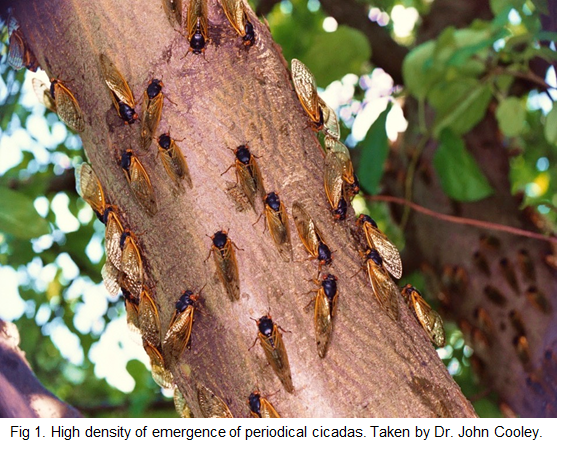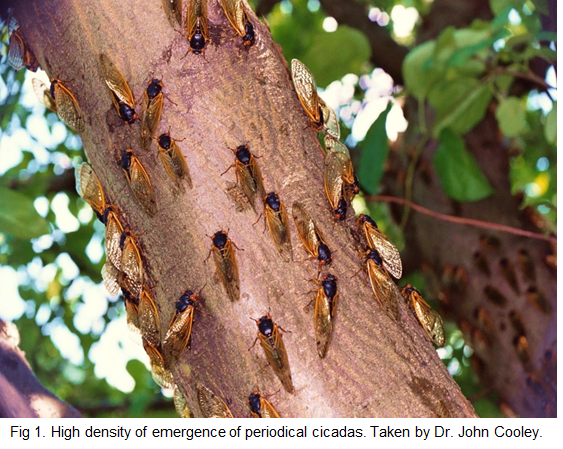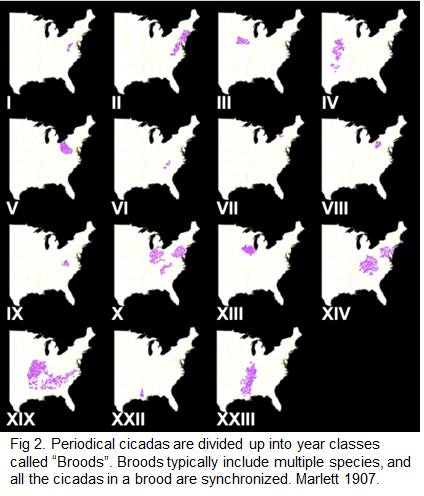 Dr. John Cooley focuses his research on the periodical cicada, and uses decades of data to map emergences of this insect. Due to methodological limits and unpredictable environmental changes, historical maps may provide inaccurate information. Dr. Cooley’s current mapping projects based on modern techniques and a better understanding of biology and biogeography are providing new insight into old ideas regarding periodical cicada distribution and emergence dynamics.  Although it is a commonly held belief that one must hunt for the most interesting phenomena in remote, exotic locations, often fascinating stories are playing out in our own backyards. One such story is that of the periodical cicada. Despite the fact many of us are familiar with the characteristic - and sometimes ear-splitting - late summer cicada choruses, it’s likely that we’ve only experienced a handful of regional periodical cicada events. A periodical cicada event occurs when groups of these insects complete an up-to-17-year maturation and emerge from the ground to the tune of millions. All periodical cicadas of the same life cycle that emerge in a given year are known as a "brood" (or "year-class"). These mixed-species “broods” are often so dense that their collective noise can reach 100 decibels, or as loud as a jet plane takeoff! As the mid-Atlantic gears up for a periodical cicada emergence in 2021, entomologist Dr. John Cooley (Wesleyan University) is using decades of data to map emergences of these charismatic arthropods. His ultimate goal is to test an age-old hypothesis that has historically been used to explain spatial patterns of the 23 known broods in the United States. The so-called “Monte Lloyd Hypothesis” states that today’s broods all came from one or more ancestral broods that were subject to climate shocks over time, which caused sub-groups to emerge early and form new area/year broods. Is this hypothesis correct? For Dr. Cooley and his colleagues, the temporal disparity in emergences makes their task quite challenging - but some recent creative analysis has begun to shed light on periodical cicada brood dynamics. According to Dr. Cooley, two key assumptions are implicit in the Monte Lloyd Hypothesis to fully explain the variation seen among broods. The first is that periodical cicada broods are spatially static over time. To test this assumption, Dr. Cooley and his team analyzed rapid survey records from a single brood found in North Carolina in 2000 and observed that it is denser in the center. When he compared the data to those from the same area in 2017, he found that cicada density had shifted on the margins of the brood range. This observation is characteristic of a presently-shifting range, and provides evidence that the broods are indeed not static.  Secondly, the Monte Lloyd hypothesis suggests that periodical cicada broods only minimally overlap spatially. While non-static broods are predicted to display a small degree of range overlap, it is highly unlikely that broods were derived from one another if overlap is shown to be widespread. Due to sampling constraints, constructing unbiased brood maps has proven to be difficult. Yet, Dr. Cooley and his colleagues have concluded that broods overlap at least slightly. Altogether, their data cast doubt on the simplicity of the Monte Lloyd Hypothesis but are not yet able to fully support any conclusions regarding its validity. Dr. Cooley’s work continues, and more details about his mapping project (and how you can get involved!) are available on his website. Dr. Cooley’s other ongoing project is focused on “Zombie cicadas”. Each cicada species has their own sound patterns, and normal male cicadas use the tymbal to create sounds that attract females of the same species. The characteristic cicada chorus is the summation of many males singing their love songs together. Females respond to males by making a flicking noise with their wings, which we can easily imitate by flicking our fingernails (here is a video of David Attenborough showing how to flick fingernails to mimic female’s response https://www.youtube.com/watch?v=tjLiWy2nT7U). However, “zombie cicadas” are hiding among these responses. These “zombie cicadas” are affected by a fungal pathogen, Massospora cicadina. Both females and males can be affected, but when the fungus grows within the abdomen of a male cicada it alters this insect’s normal mate-seeking behavior. As a result, infected males begin to flick their wings like females, in response to other male’s songs. Thus, when uninfected males attempt to mate with the zombie males they are infected with the fungal spores. The lifecycle of M. cicadina has two major infection stages. In the first stage, fungal spores exist in soil and are picked up by cicada nymphs as they come in contact during emergence. These infected adults will exhibit the zombie phenotype and transfer the fungus during attempted mattings, resulting in a stage II infection. Finally, the resting spores return to the soil from eggs laid by infected females and wait for the next round of emergence. The survival mechanisms of the fungus during the waiting period, such as diapause, are not yet clearly known and more specific experiments are ongoing. Dr. Cooley encourages cooperation between researchers in long-term and spatially vast projects like the periodical cicada project. Mapping periodical cicadas has taken place for over a century, but due to methodological limits and unpredictable environmental changes, earlier maps may provide inaccurate information. Current mapping based on modern transportation, GPS technology, and a better understanding of biology and biogeography provide critical insights into periodical cicada speciation, behavior, and gene flow, and extend utility for related research fields to further cicada mapping records. Bloggers Mengyao Chen is a PhD student in Dr. Leslie Pick’s Lab. Her research focuses on segmentation genes in Brown Marmorated Stink Bug (BMSB, Halyomorpha halys) and Firebrat (Thermobia domestica). Graham Stewart is an MSc student in Dr. Margaret Palmer’s lab. His research focuses on the biotic and abiotic drivers of carbon sequestration in freshwater wetlands. Reference Cooley, J. R. 2004. Asymmetry and mating success in a periodical cicada, Magicicada septendecim (Hemiptera: Cicadidae). Ethology 110:745-759. Comments are closed.
|
Categories
All
Archives
June 2024
|
Department of Entomology
University of Maryland
4112 Plant Sciences Building
College Park, MD 20742-4454
USA
Telephone: 301.405.3911
Fax: 301.314.9290
University of Maryland
4112 Plant Sciences Building
College Park, MD 20742-4454
USA
Telephone: 301.405.3911
Fax: 301.314.9290

 RSS Feed
RSS Feed




